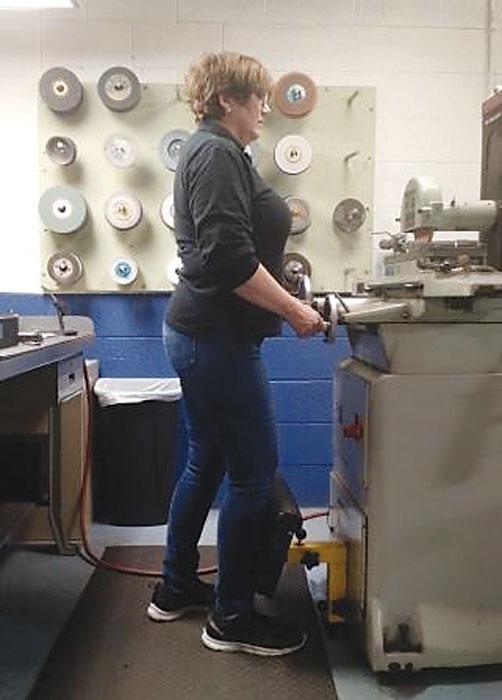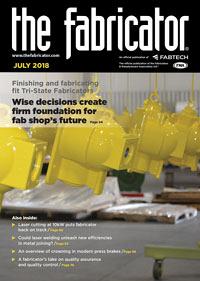Editor-in-Chief
- FMA
- The Fabricator
- FABTECH
- Canadian Metalworking
Categories
- Additive Manufacturing
- Aluminum Welding
- Arc Welding
- Assembly and Joining
- Automation and Robotics
- Bending and Forming
- Consumables
- Cutting and Weld Prep
- Electric Vehicles
- En Español
- Finishing
- Hydroforming
- Laser Cutting
- Laser Welding
- Machining
- Manufacturing Software
- Materials Handling
- Metals/Materials
- Oxyfuel Cutting
- Plasma Cutting
- Power Tools
- Punching and Other Holemaking
- Roll Forming
- Safety
- Sawing
- Shearing
- Shop Management
- Testing and Measuring
- Tube and Pipe Fabrication
- Tube and Pipe Production
- Waterjet Cutting
Industry Directory
Webcasts
Podcasts
FAB 40
Advertise
Subscribe
Account Login
Search
Aid helps to eliminate shop floor pain
A grinding shop owner finds a way to eliminate back and joint pain while operating machinery
- By Dan Davis
- July 17, 2018
- Article
- Shop Management

Figure 1
Cathy Sitek operates one of the manual grinders at her shop, United Manufacturing Network. She is leaning on a StandRite-Pro support, which she and her husband Jerry designed to relieve pain that operators might endure while standing in front of a machine tool for a long time.
What do manufacturers do best? They find out how to make things better.
That’s what grinding shop owners Cathy and Jerry Sitek did as Cathy struggled with chronic body pain upon entering her 50s. She was busy enough, but the activity wasn’t doing damage to her body. It was the inactivity—the several minutes at a time of standing over one of her grinders as she was dialing in a job and then repeating that effort for similar parts that were part of the same job.
So in 2015 she and her husband and co-owner, Jerry Sitek, began investigating what could be causing her pain. They developed some prototypes that ultimately led them to creating and patenting the StandRite-Pro™, an aid that is designed to relieve machine tool operators’ pain as they lean into it.
“What do you do when something is broken?” Cathy said. “You look at the blueprint.”
After looking at the human body as it is standing at a machine and figuring out how chronic pain could be minimized, the Siteks may have found a pain reliever that will be of interest to anyone who has to linger in front of a machine tool for repetitive jobs throughout a shift. In short, they took a stand to find out how others could stand without pain (see Figure 1).
Following the Manufacturing Path
It’s no surprise that Cathy ended up in a manufacturing career. Her dad owned a job shop and gave her the opportunity to get experience operating machines and being on a shop floor. By 16, she knew that she wanted to own a company that was involved in manufacturing.
By 20 she started her own grinding company, after buying a machine and knocking on doors for customers. After that she started United Gage and built precision gauges for government and manufacturing customers.
She stepped away from the business so that she could raise her family. She knew she couldn’t be an effective parent if she brought home the stress that built up over a day at her fixture-building company.
“I didn’t understand the stress that I was experiencing at the time. It was stress from standing for most of the day. I was just sapped of energy by the end of the day,” she said.
As the kids got older, Cathy started United Manufacturing Network (UMN), a distributor of grinding machines, in the mid-2000s. She enjoyed some success, even selling some machines to a large automotive company.
But the Great Recession changed all of that because no one was buying new equipment. For about an eighth of what it normally would have cost during robust economic times, Cathy bought a used jig grinder that was headed for scrap. Knowing that everyone needs grinding services, she was ready to hit the manufacturing grind again. (That grinder is still actually a part of the company’s equipment mix. Cathy said that she can still achieve tolerances as tight as 0.0001 in. on it.)
Cathy met Jerry in 2012, and they decided to combine forces on the business side of their lives in 2014. Jerry, formerly a manager of a construction company, would handle the business side of the company and focus on customer development, and Cathy was going to do what she did best: deliver expert grinding work. Success had its price, however.
“I was bringing in a lot of work and building up some revenue, but it was killing us,” Jerry said.UMN was evolving into a successful small business, providing jig, surface, wet surface, outer diameter, and inner diameter grinding for customers. But the manufacturing responsibilities were falling on Cathy’s shoulders. The plan had called for bringing in additional employees for training, but no one really showed interest in learning the trade, especially when they might be able to work with CNC equipment for a few dollars more down the street. Meanwhile, Cathy was routinely standing over her grinders several minutes at a time, dialing in jobs and then finishing production orders.
“It’s the repetition and the reaching for the controls on the machine repeatedly,” Jerry said.
Cathy was experiencing back, foot, and shoulder pain, and it was sabotaging productivity. Stretching exercises, new shoes, and rubber mats—none helped. That’s when the couple began a more formal investigation into ways to relieve the pain.
Finding the Right Support
Cathy and Jerry knew what was causing the pain. Cathy also realized that she got brief respites from it when she was able to lean on something, either against the grinding machine or by putting a hand on a nearby wall or chair. That got her to thinking that if she could develop a support of some kind, she could relieve some of the pain associated with standing all day.
Cathy started with a shower seat and added some bracing to it. She intended to place a knee on it as she worked in front of her grinders, but she realized that she experienced more pain relief when she actually leaned into it.
“It’s funny because once I started feeling better, my cognitive thinking started to go off the charts,” she said. “I was just thinking a lot better.”
The pain relief energized her to focus on looking at biological reasons behind the pain. They discovered a lot of research that investigated human posture and body movement, but nothing that really tied into activities, such as running manufacturing equipment, that required a lot of standing. (Lending credence to the fact that this area has yet to be fully explored, a study published in the Nature Journal Scientific Reports earlier this year suggests that a fluid-filled network of tissue that sits just below the skin is actually the largest organ in the body, as it has a unified structure and purpose, acting as infrastructure for interstitial fluid to travel throughout the body. New imaging technology made discovery of this organ possible.)
In exploring why pain may be occurring as a result of standing, Cathy and Jerry spent a considerable amount of time exploring postural sway, the motions necessary to maintain a vertical line of center mass—or, in other words, standing still. Jerry said that as a result of their research they believe the body’s fascia tenses nonstop while standing, which results in fatigue and pain over an extended time frame. That’s what leads people to seek out a means to stabilize the body during the day as they are asked to stand in front of a machine during a shift.
With this realization, the couple founded Human Balance and Stability Systems (HBSS) in 2016 to produce a product that could do for others what they found could do for Cathy. Early prototypes soon focused on a standing aid that would engage the operators at the shin. Unlike the shower seat prototype, which did not allow the operator to get close enough to the machine, this fabrication provided the support necessary for the operator and did not take up too much space.
The key to success for what was to become the StandRite-Pro (see Figure 2) is that the aid steadies the machine operator when he or she is leaning against it. Postural sway is reduced, and as a result, so is the wear and tear on the musculoskeletal system.
Additionally, because the shins are the strongest bones in the body, they are able to absorb impact between the body and the standing aid. Also, because the operator is leaning while engaged with the support, the knees are not locked, and pressure is not totally directed to the back.
Confident that they had something worth further investment, Cathy and Jerry got a provisional patent for the invention in November 2015 and secured adequate intellectual property protection in June 2016.
Based on some positive feedback from beta users at nearby machine shops and even a grocery store, HBSS pursued a manufacturing partner in 2017. Now it is in a position to produce thousands at a time when needed.
Through a Macomb-Oakland University Incubator Business Acceleration Fund grant, they even engaged a professor at Oakland University in Rochester, Mich., to formalize their claims about the StandRite-Pro product. Subsequent research revealed that reaching movements, such as lifting parts out of a machine, did not put as much force on the lower back when the operator was engaged with the standing aid. The torque on the lower back was reduced on average by 18 foot-pounds when compared to when an operator was engaging with a machine without any support. Additionally, calculations were made to confirm that leaning against the standing aid reduces an individual’s total weight load by 20 percent.
“We’re cautiously optimistic that not only are we going to improve productivity and the bottom line for companies, but we’re also going to have a positive and measurable impact on health care in general,” Cathy said.
Human Balance and Stability Systems, www.hbssco.com
About the Author

Dan Davis
2135 Point Blvd.
Elgin, IL 60123
815-227-8281
Dan Davis is editor-in-chief of The Fabricator, the industry's most widely circulated metal fabricating magazine, and its sister publications, The Tube & Pipe Journal and The Welder. He has been with the publications since April 2002.
subscribe now

The Fabricator is North America's leading magazine for the metal forming and fabricating industry. The magazine delivers the news, technical articles, and case histories that enable fabricators to do their jobs more efficiently. The Fabricator has served the industry since 1970.
start your free subscription- Stay connected from anywhere

Easily access valuable industry resources now with full access to the digital edition of The Fabricator.

Easily access valuable industry resources now with full access to the digital edition of The Welder.

Easily access valuable industry resources now with full access to the digital edition of The Tube and Pipe Journal.
- Podcasting
- Podcast:
- The Fabricator Podcast
- Published:
- 04/30/2024
- Running Time:
- 53:00
Seth Feldman of Iowa-based Wertzbaugher Services joins The Fabricator Podcast to offer his take as a Gen Zer...
- Industry Events
Pipe and Tube Conference
- May 21 - 22, 2024
- Omaha, NE
World-Class Roll Forming Workshop
- June 5 - 6, 2024
- Louisville, KY
Advanced Laser Application Workshop
- June 25 - 27, 2024
- Novi, MI
Precision Press Brake Certificate Course
- July 31 - August 1, 2024
- Elgin,
































